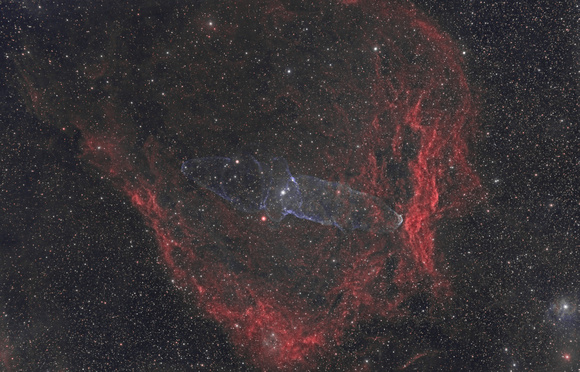Squid (Ou 4) Carried by a Flying Bat (SH2-129) in SHO
SH2-129 (Flying Bat) and Ou4 (Squid) Nebulae- SHO (Hubble Pal) - Jun 2022
Televue 128is - AIS6200MM
A-P 1100 GTO AE, Antlia Pro 3nm NB filters
SHO (3 x 24 x 600s exposures) = 12 hours, Bin2x2, Gain=100!
The Squid nebula (Ou4) was only first observed/discovered in 2011 and actually lies within the SH2-129 nebula, making it a interesting target that I had to capture. They lie in Cepheus, approximately 9000 LY from us. SH2-129 is 271 ly in diameter, occupying 100 arcminutes of sky. Ou-4, was first observed by Nicolas Outters, and hence the rare catalogue number. Clearly the nebulae are made of different gases and don't really seem to correlate with one another. I am curious about how they came to be and if they are associated at all.
This was my first image that I lost significant sleep over trying to think how best to process it. The squid is only visible through the [OIII] filter and is a fairly weak signal, compared to the dominant [SII] signal and extremely dominant hydrogen signal. (I imagine that this is why it is a recent discovery). The struggle involved juggling the Squid signal so that it could clearly be seen, jet transluscent enough to both illustrate its ethereal quality and let the port bat wing come through. At the same time, i needed to construct a linear luminance image in order to perform deconvolution to bring out details in the bat. Processing in HOO would have been easier / better, but I was also trying to highlight the S[II] signal, but perhaps this was a "bridge too far" for me.
Obvious mistakes I made include too much backfocus from my wide-field corrector and a whole nights worth of trashed frames where I forgot to turn on the camera cooler - there is a lot more noise at 28C than at -10C.
THe reflection/emission nebula in the llower right of the frame is a nice bonus. I did collect RGB data to replace the narrowband stars, but they are pretty good so I'm going to leave that for another day.
I have long be trying to capture a decent image of Ou-4 and SH2-129 and even attempted this last year, but I couldn't get the Squid to stand out enough.


